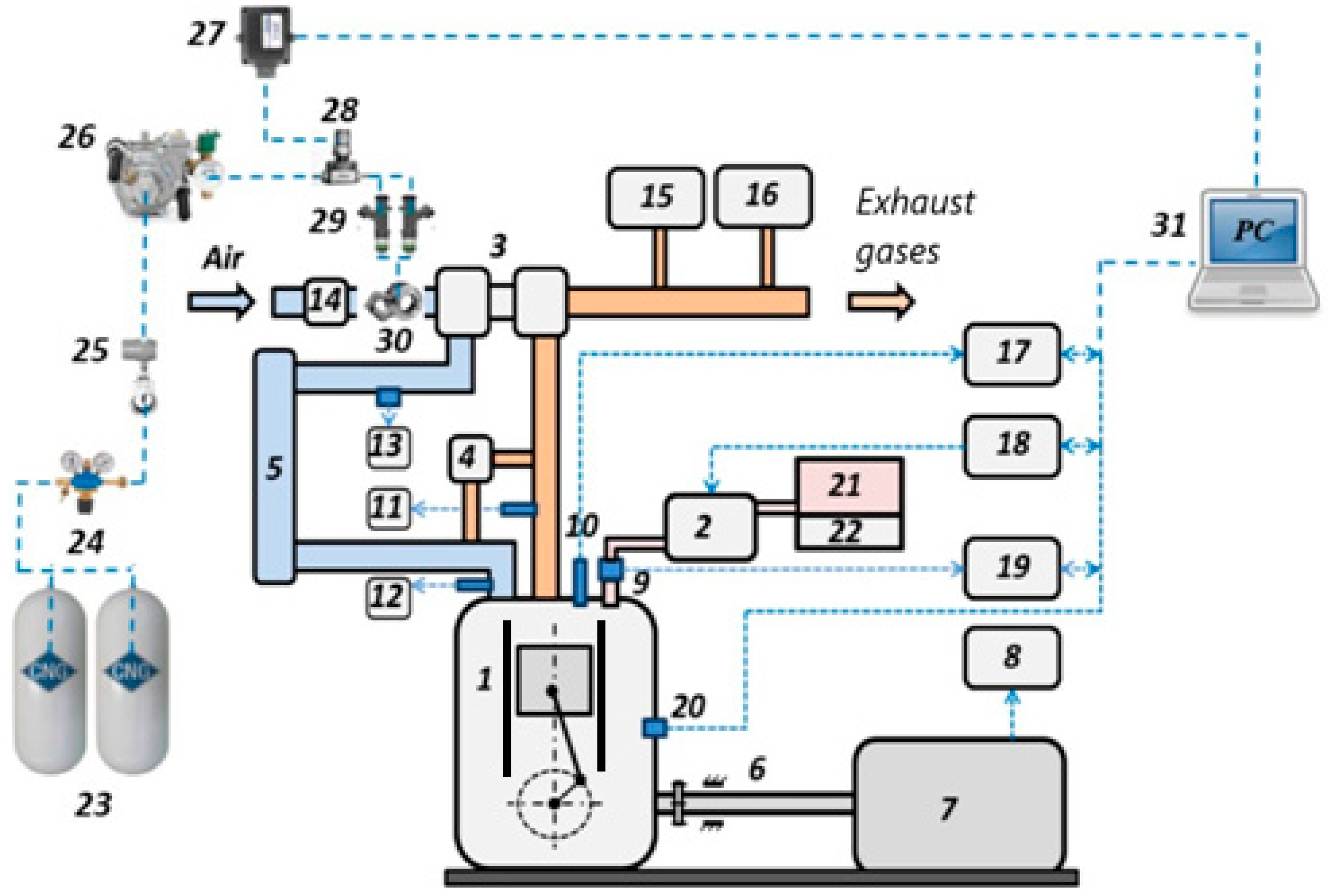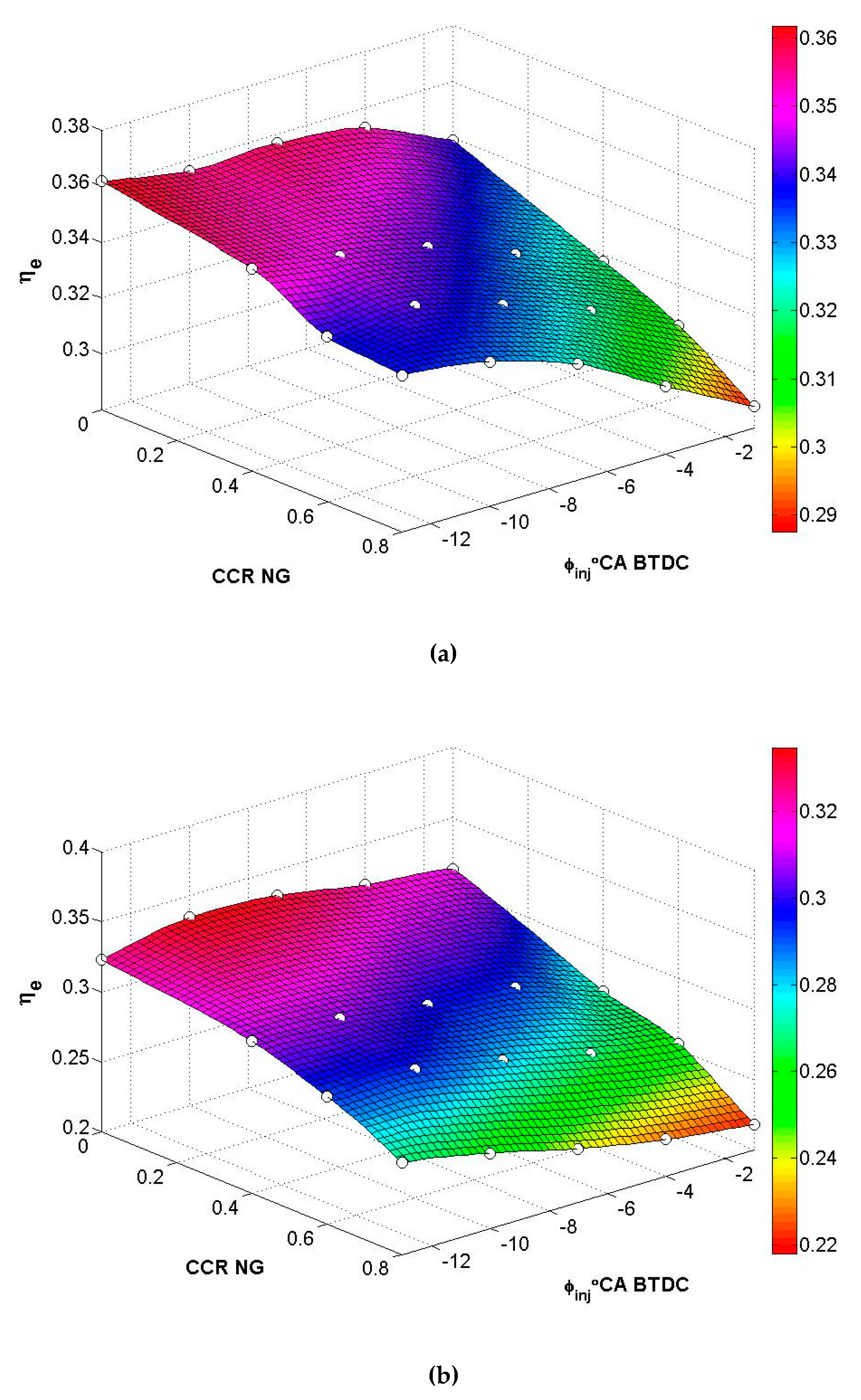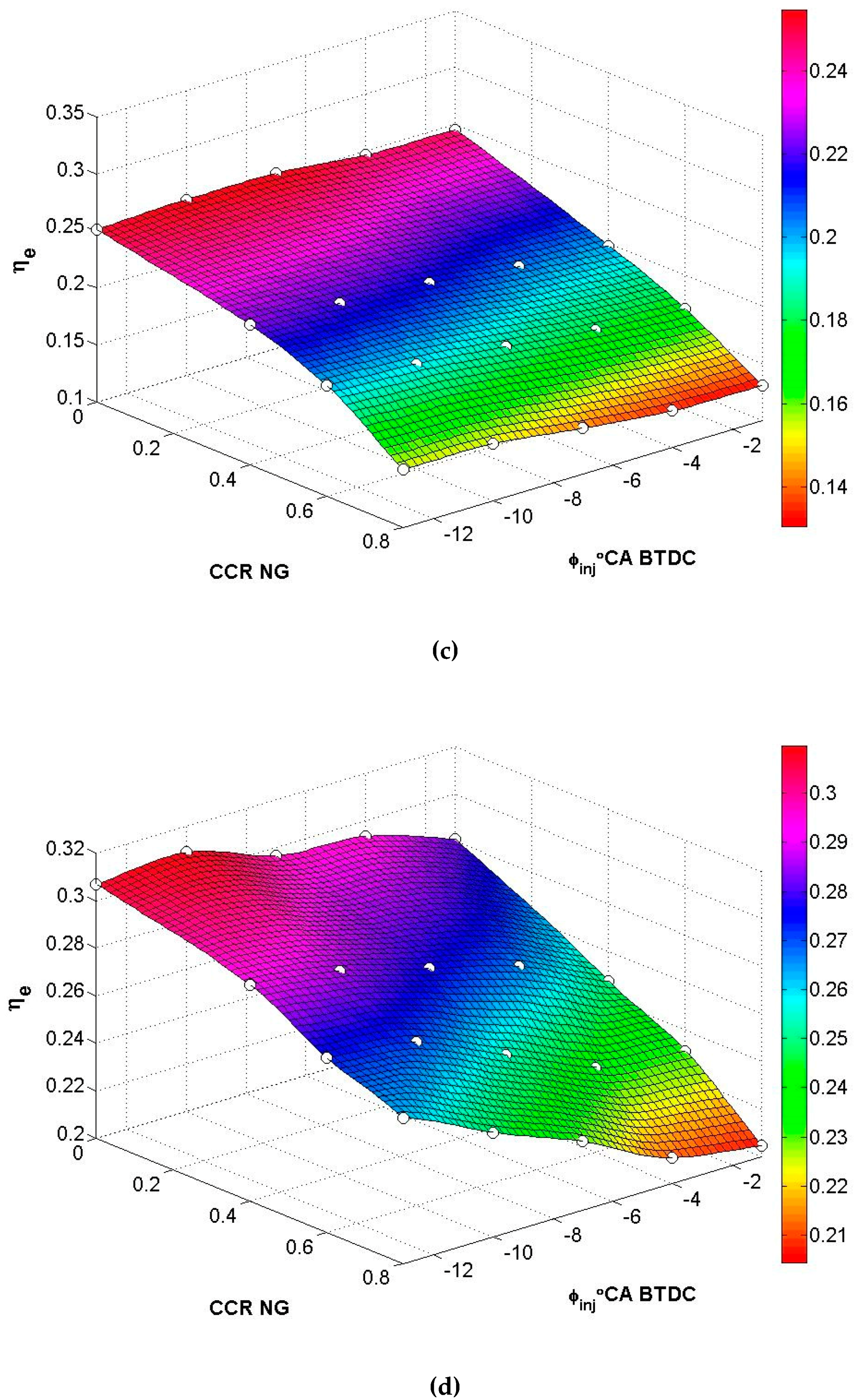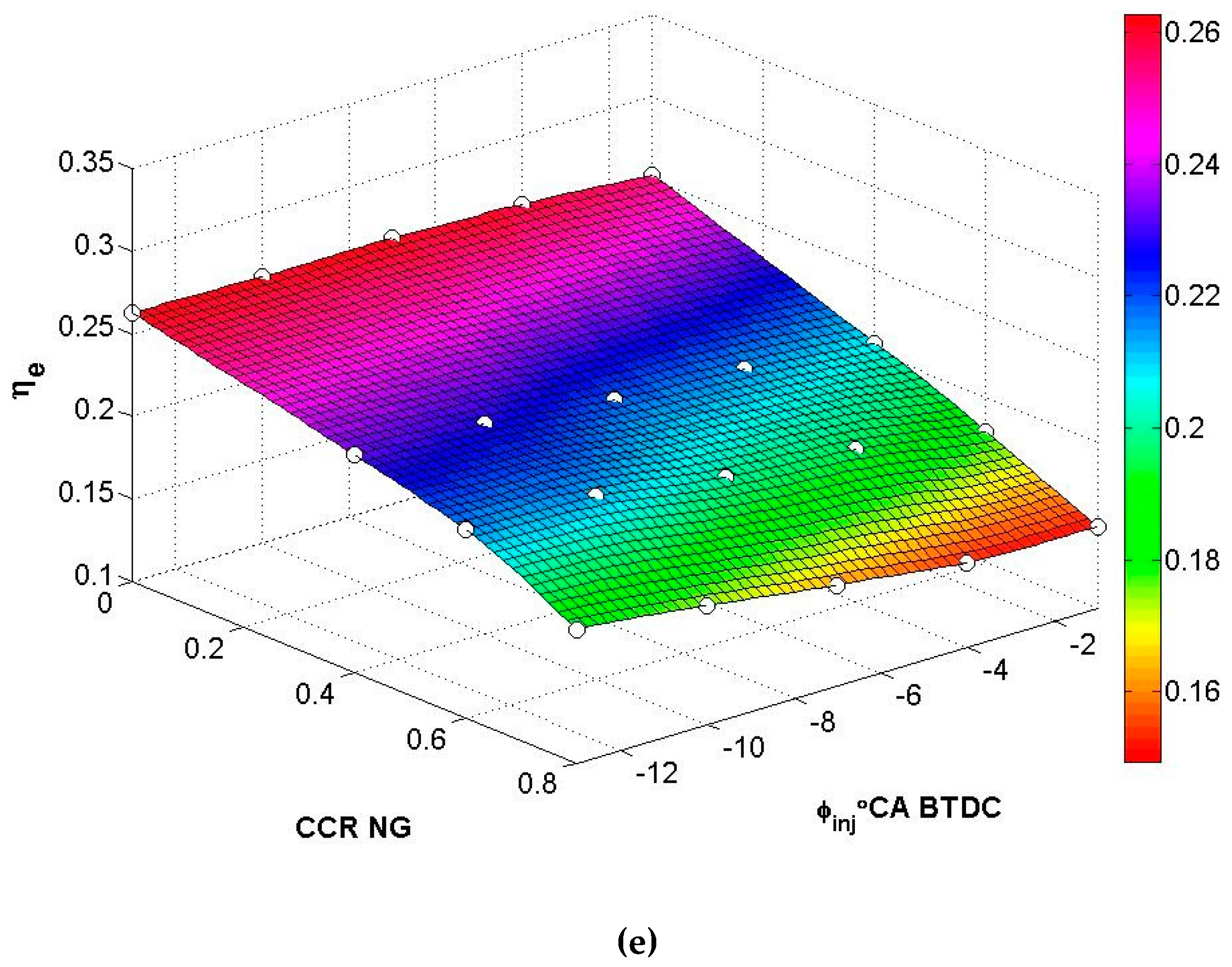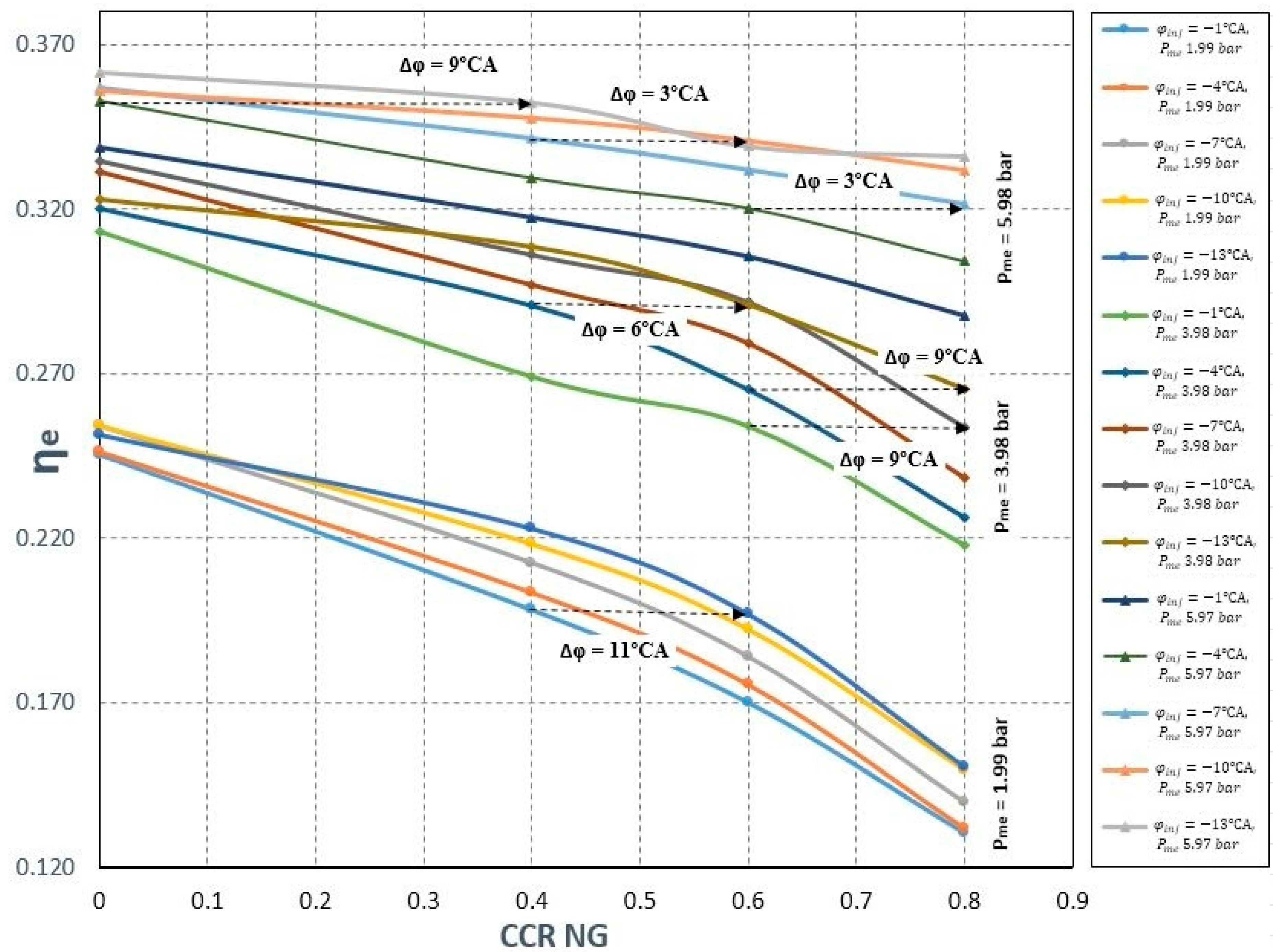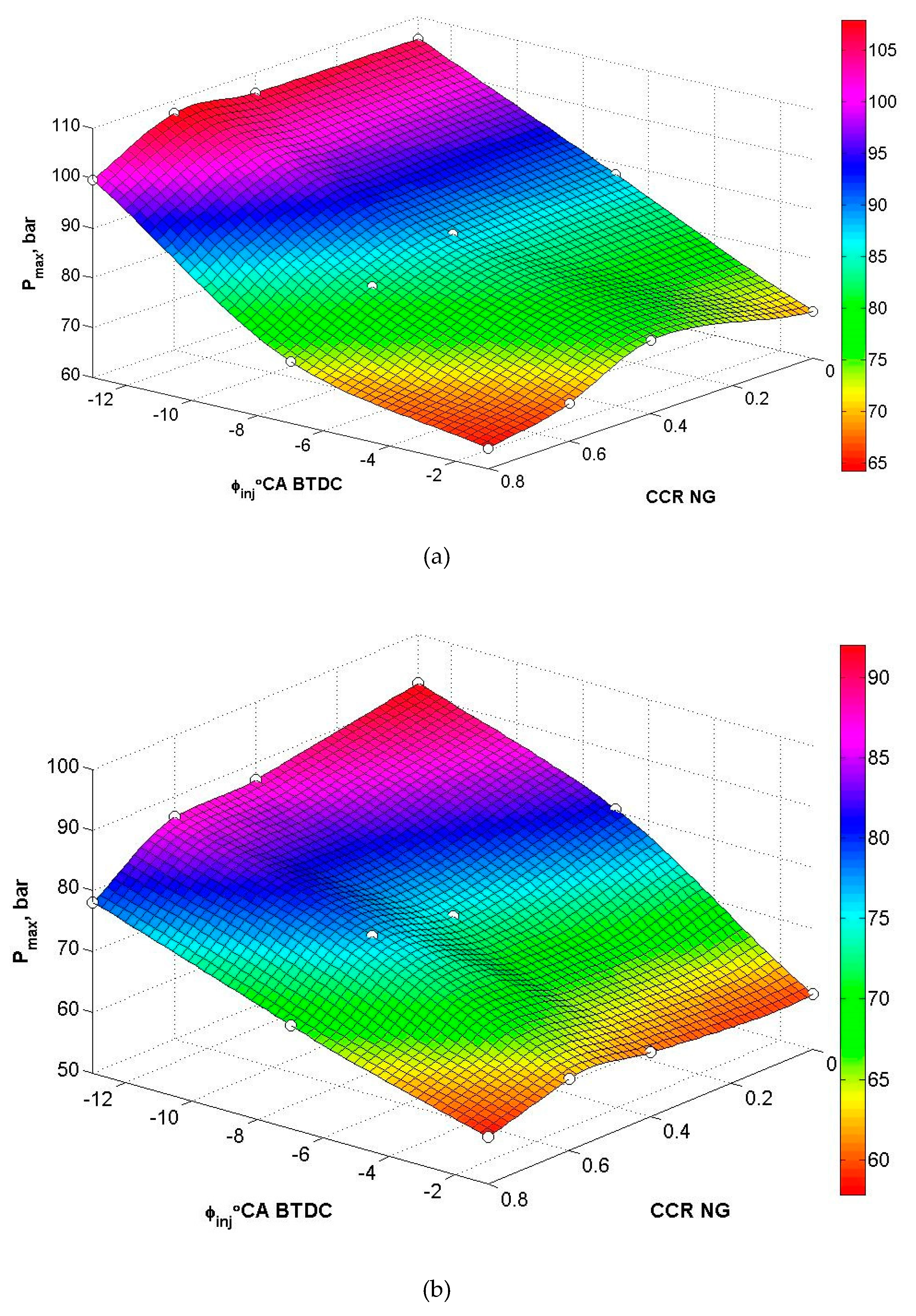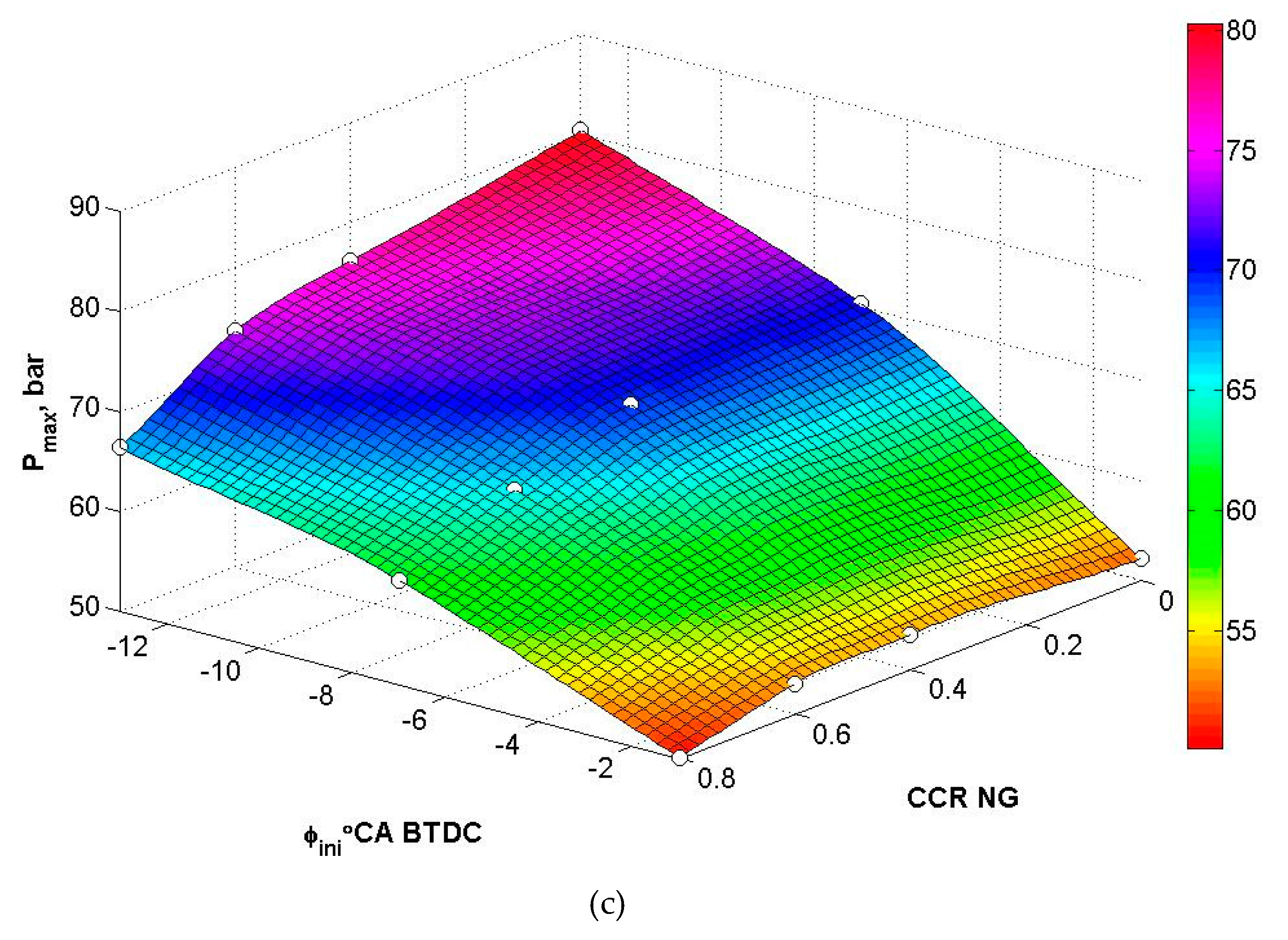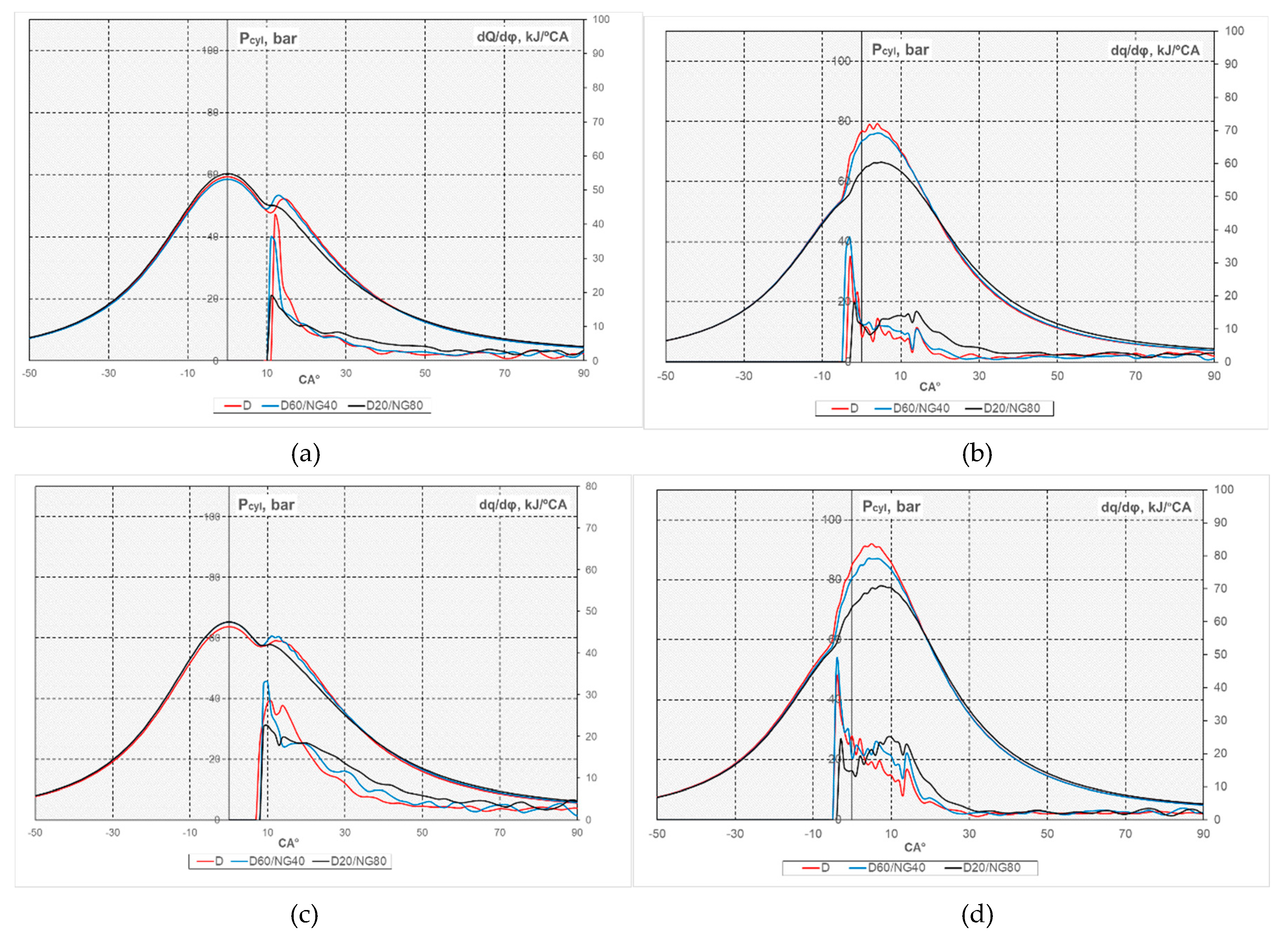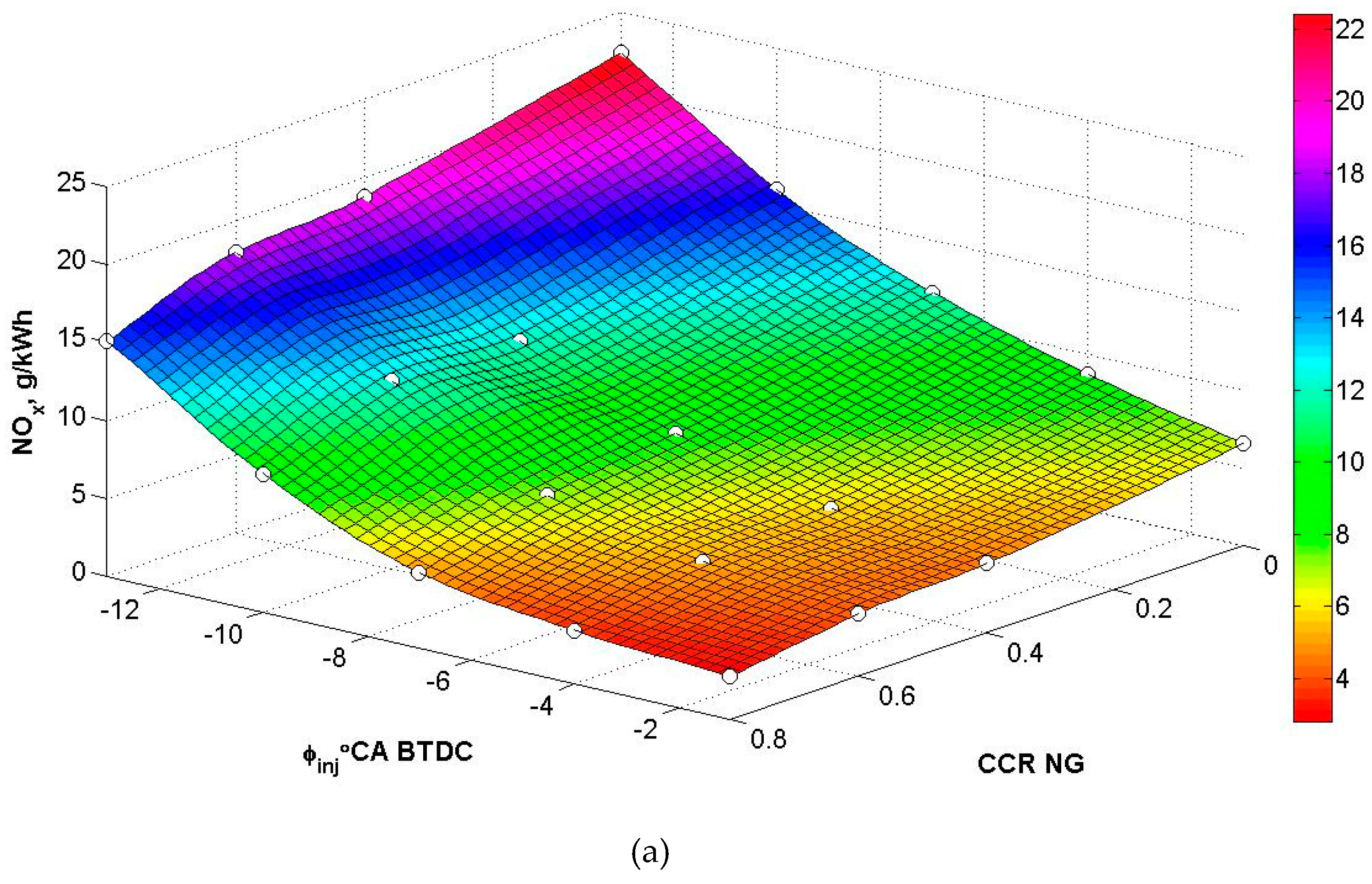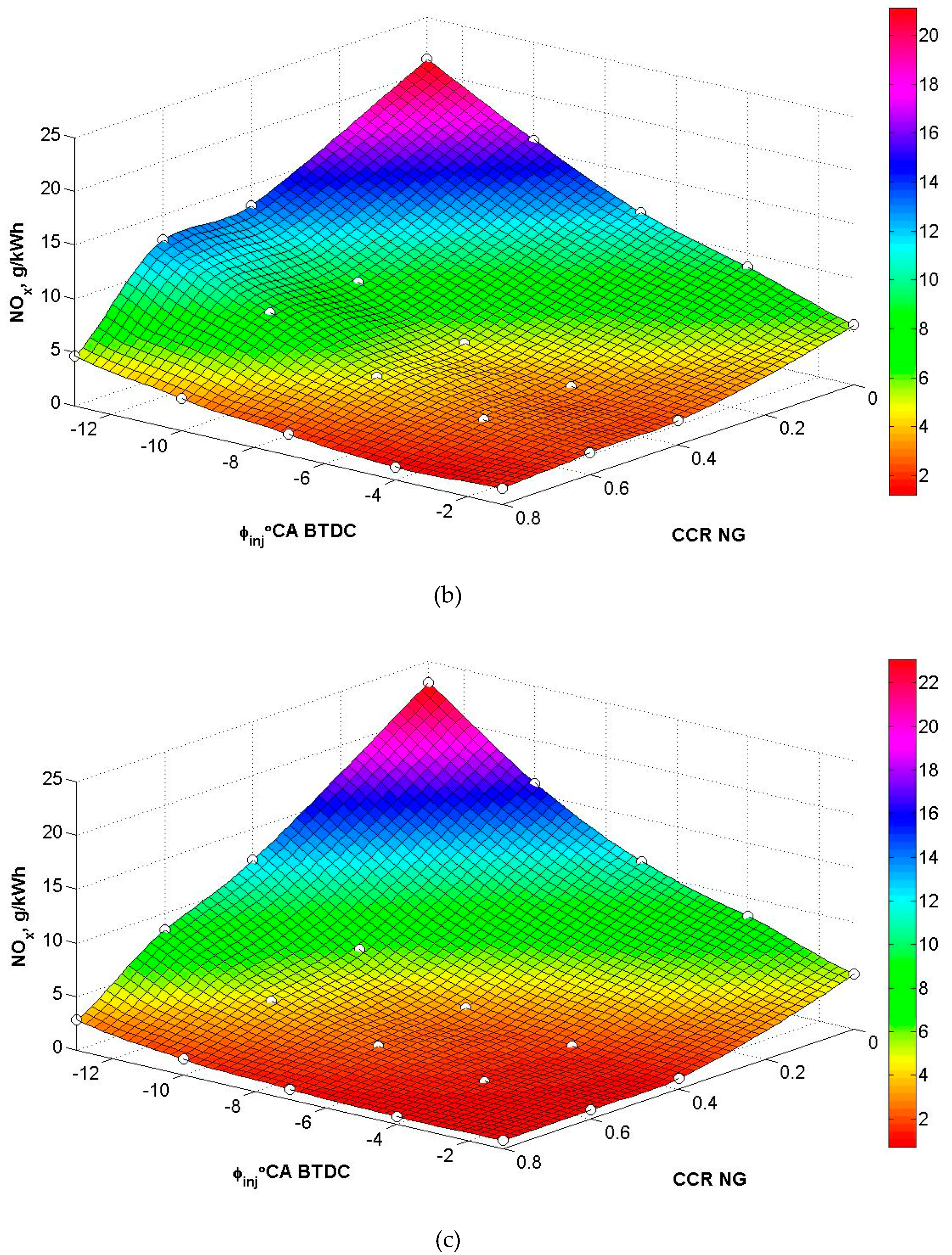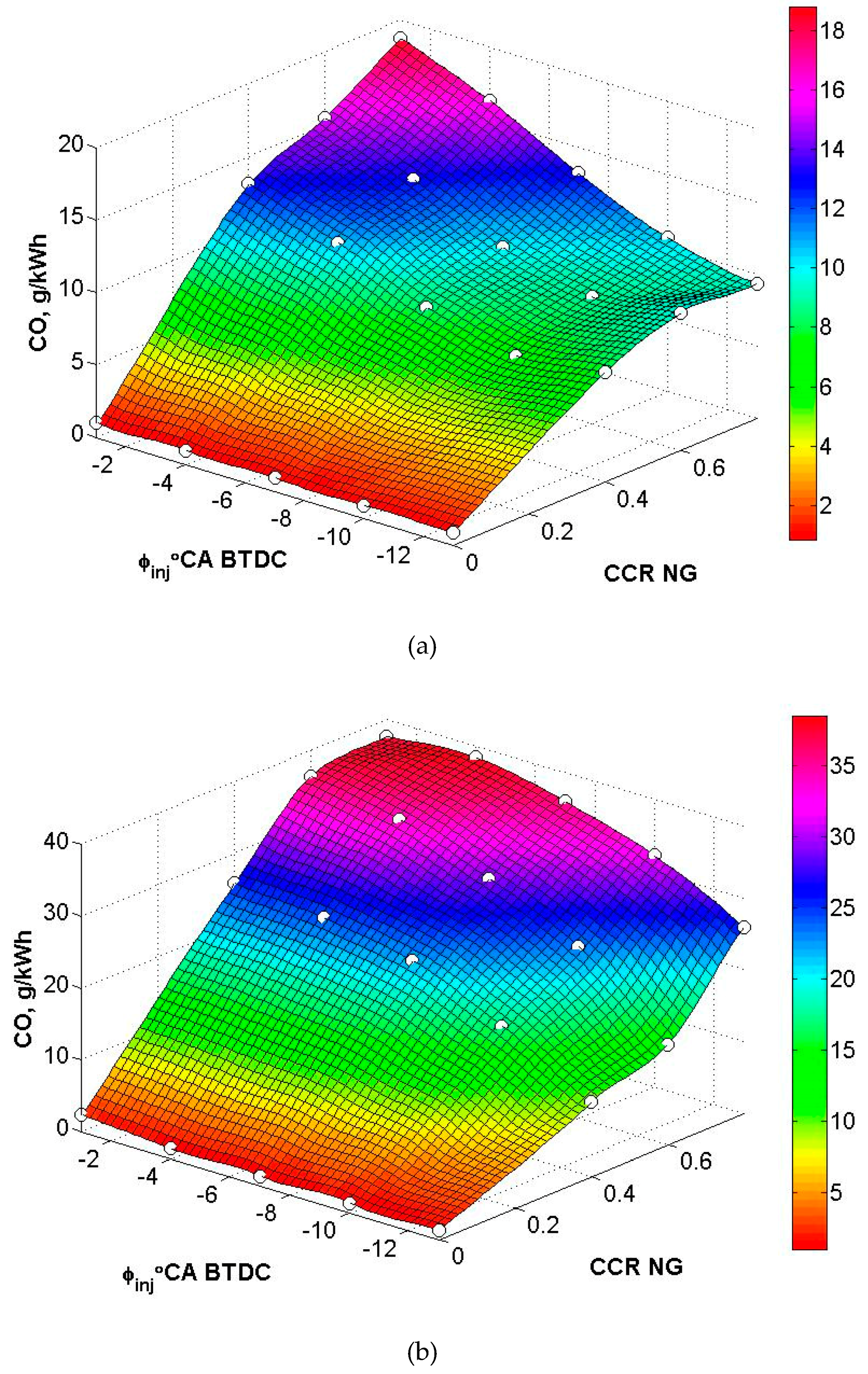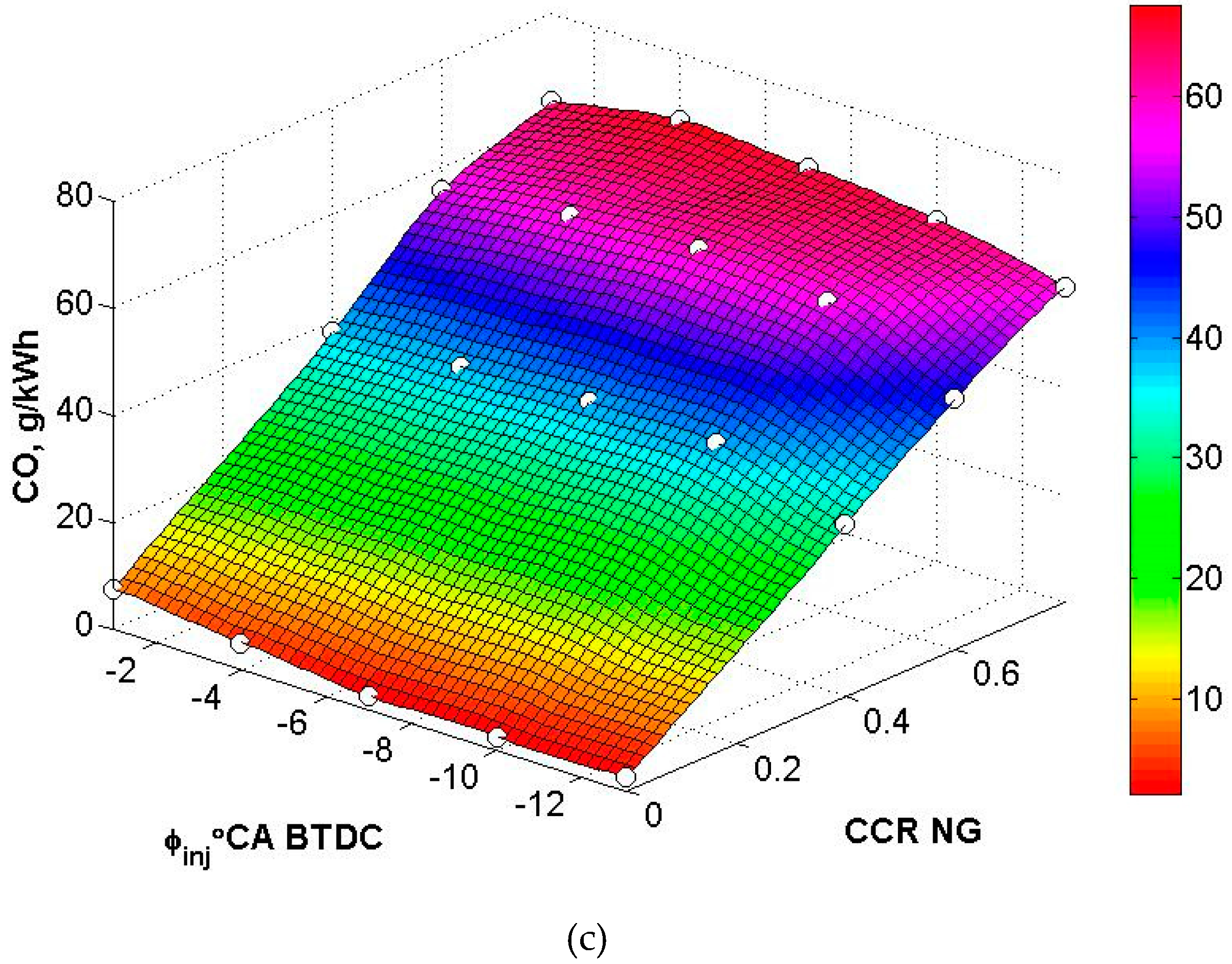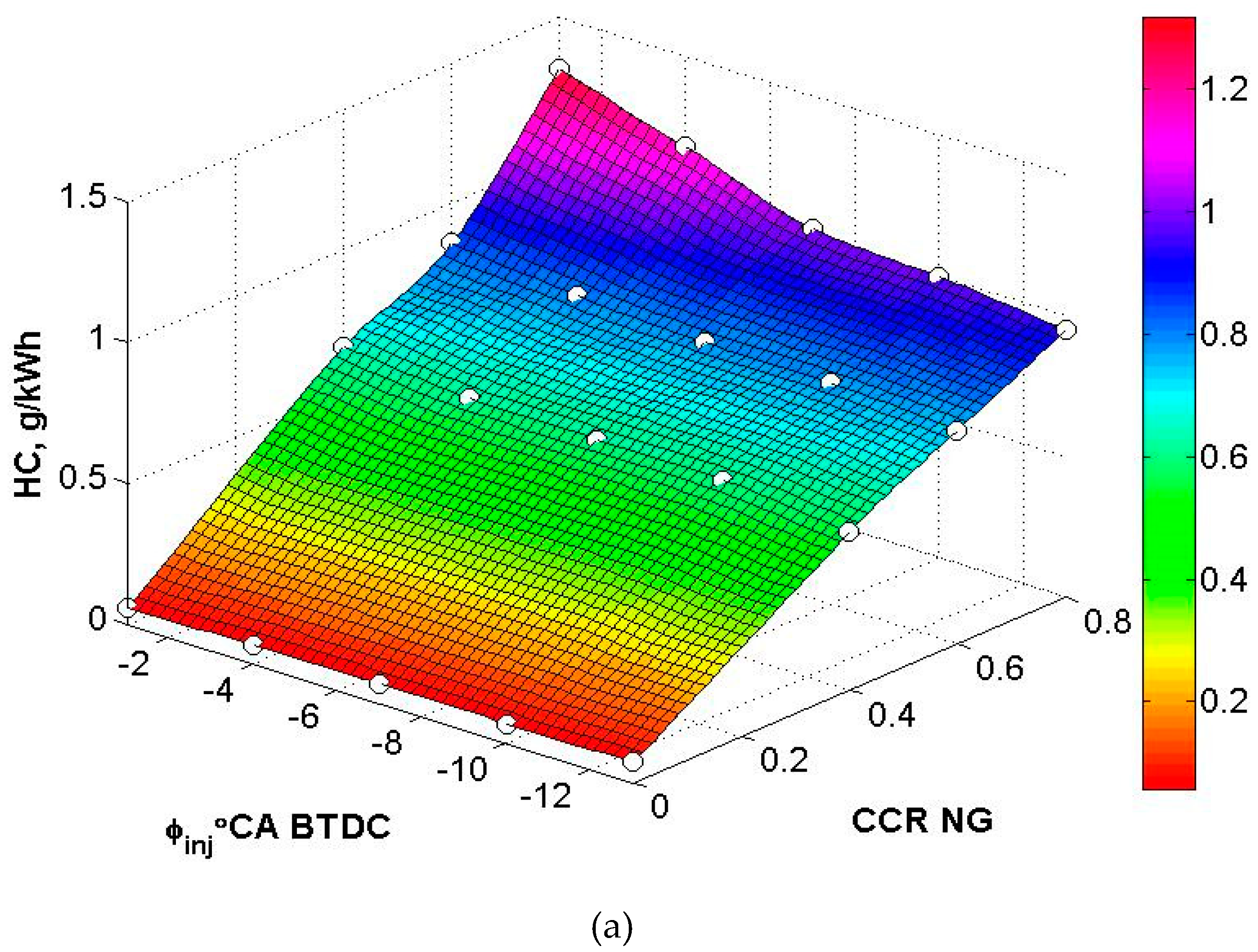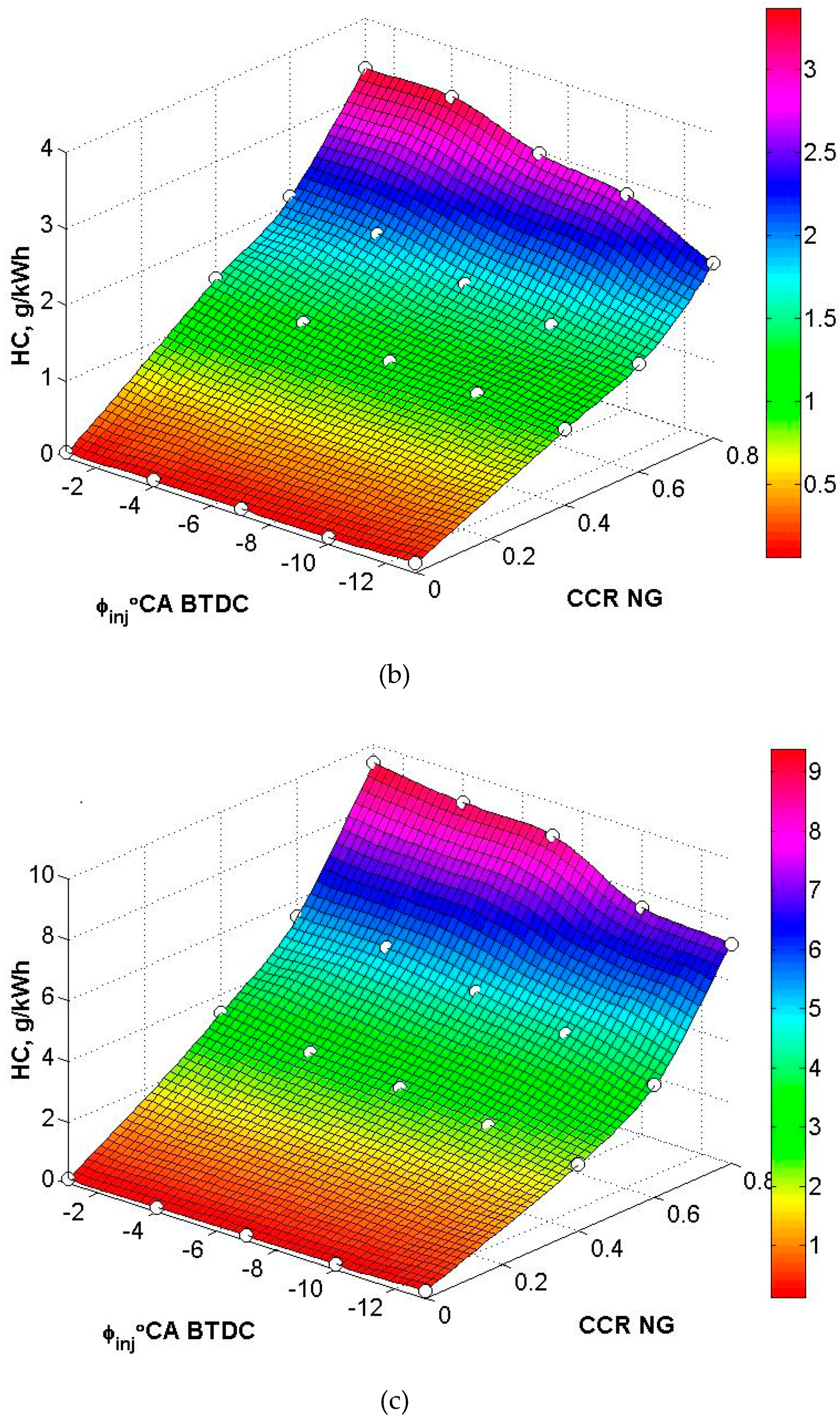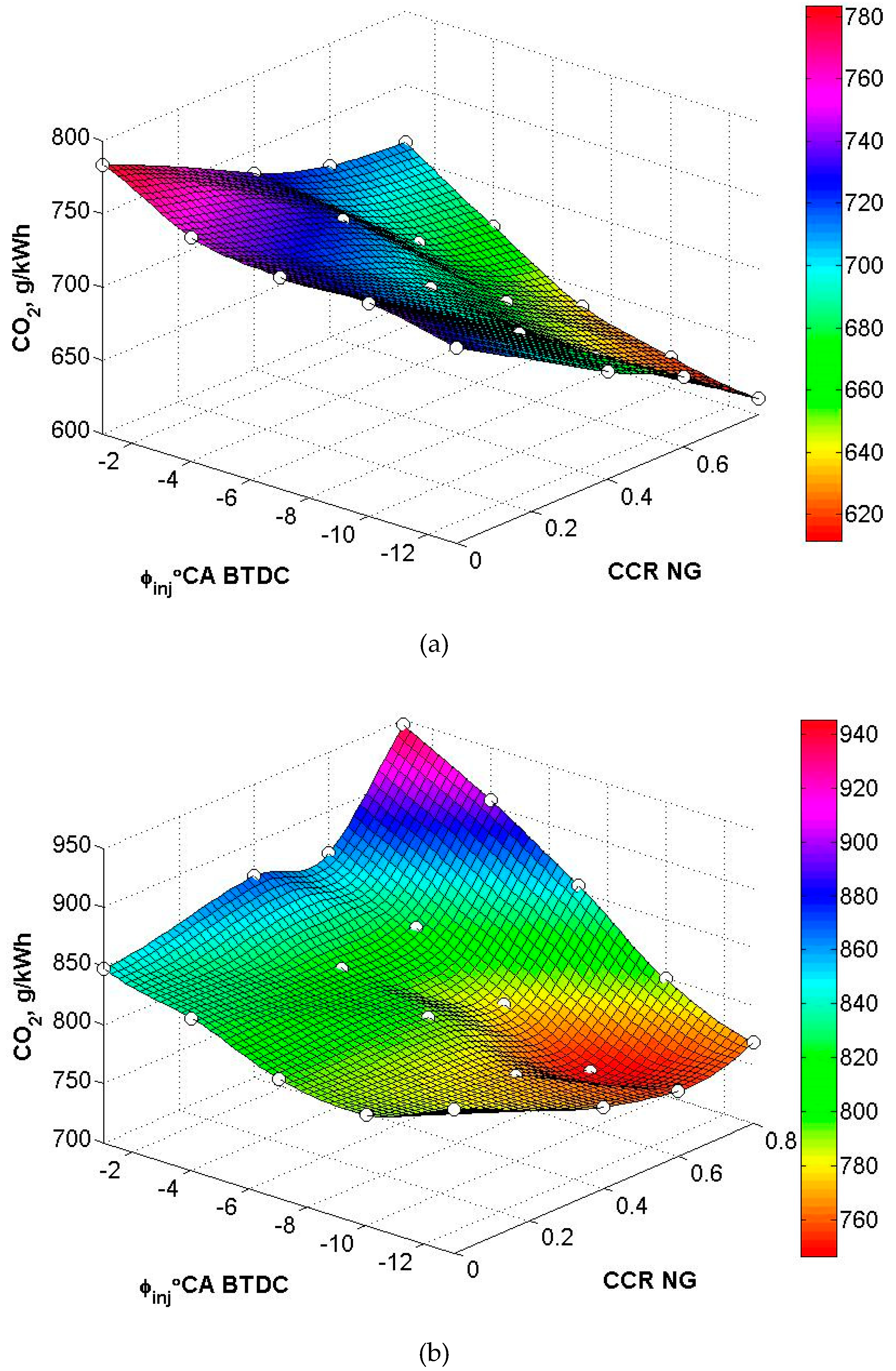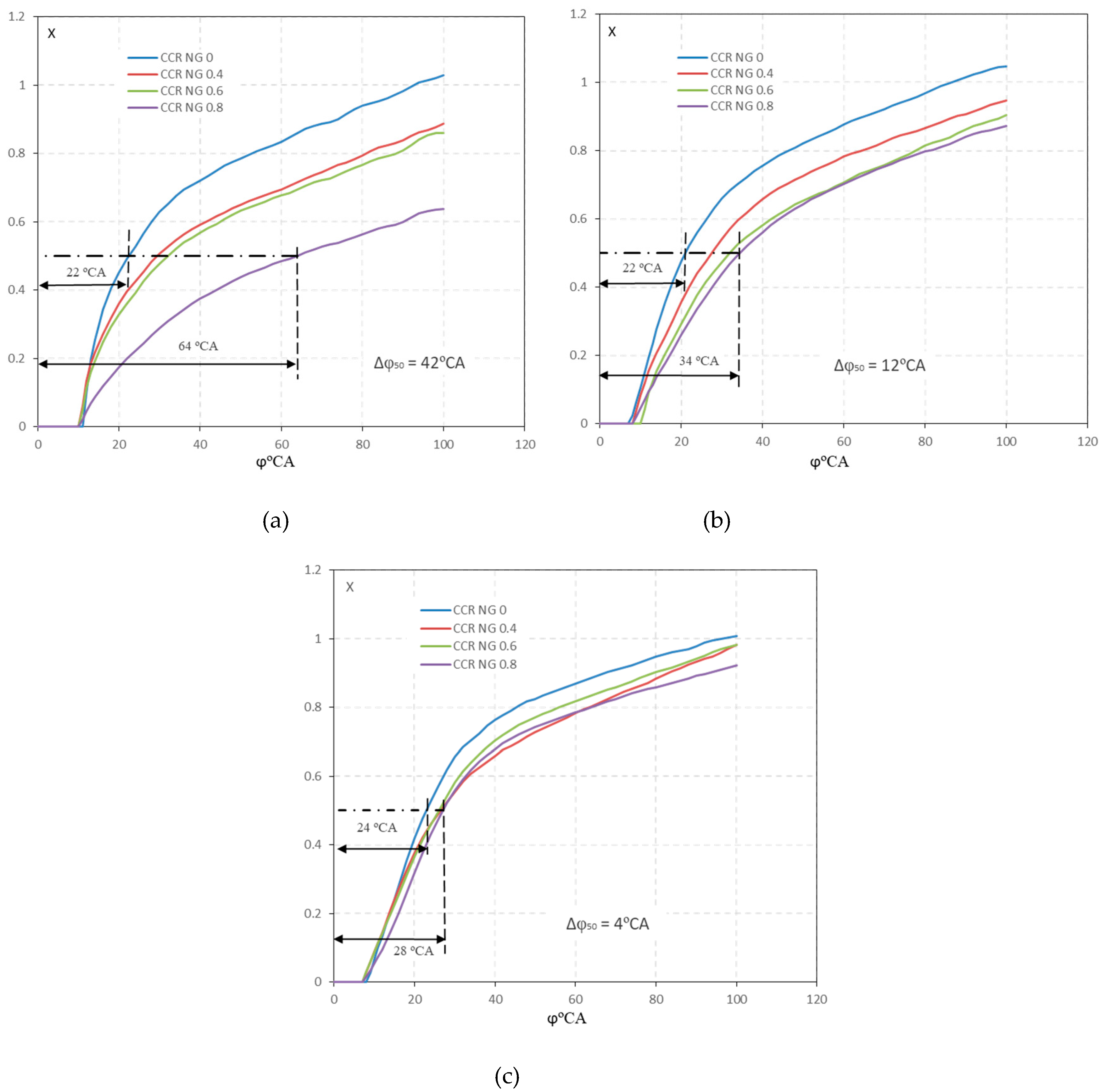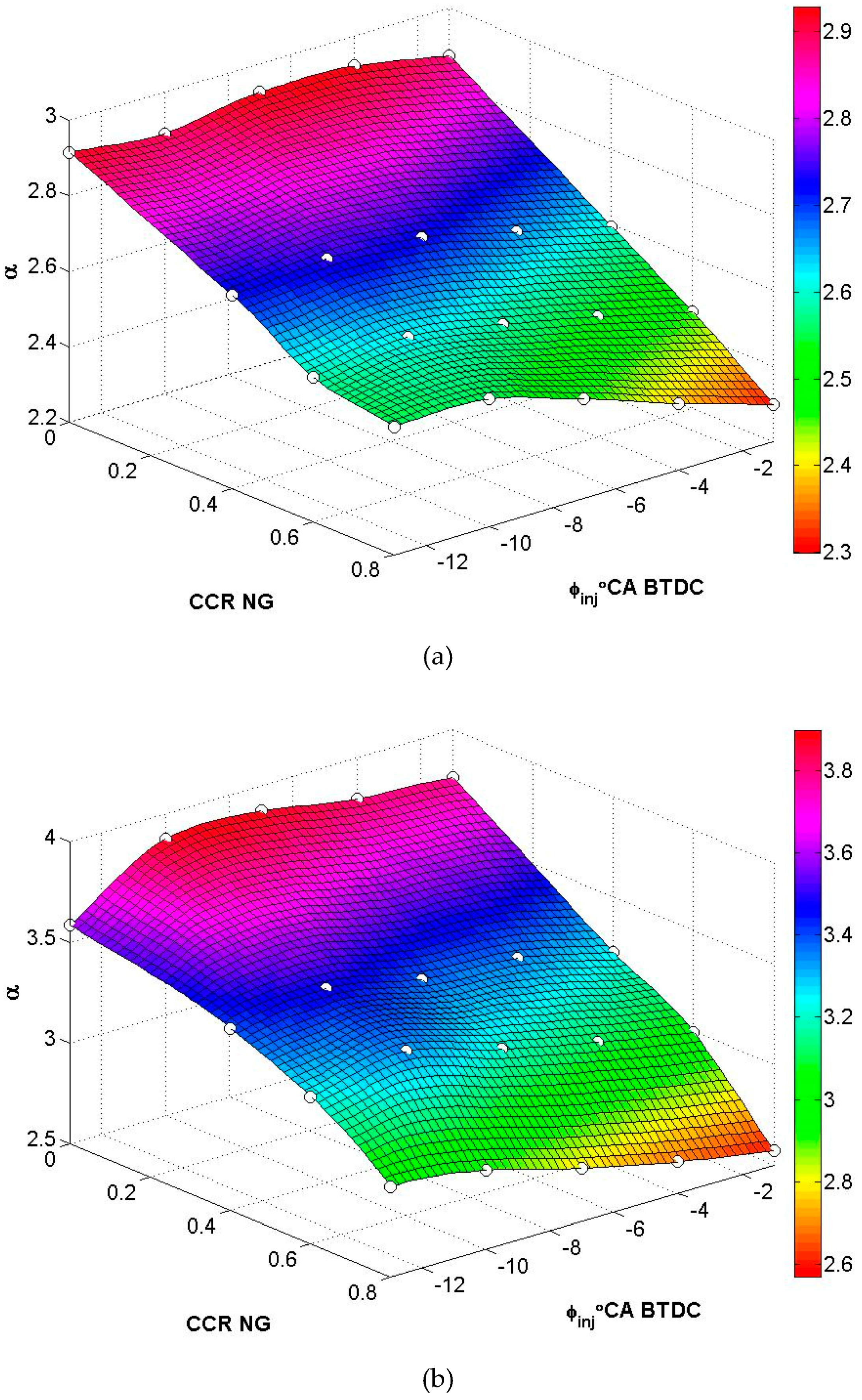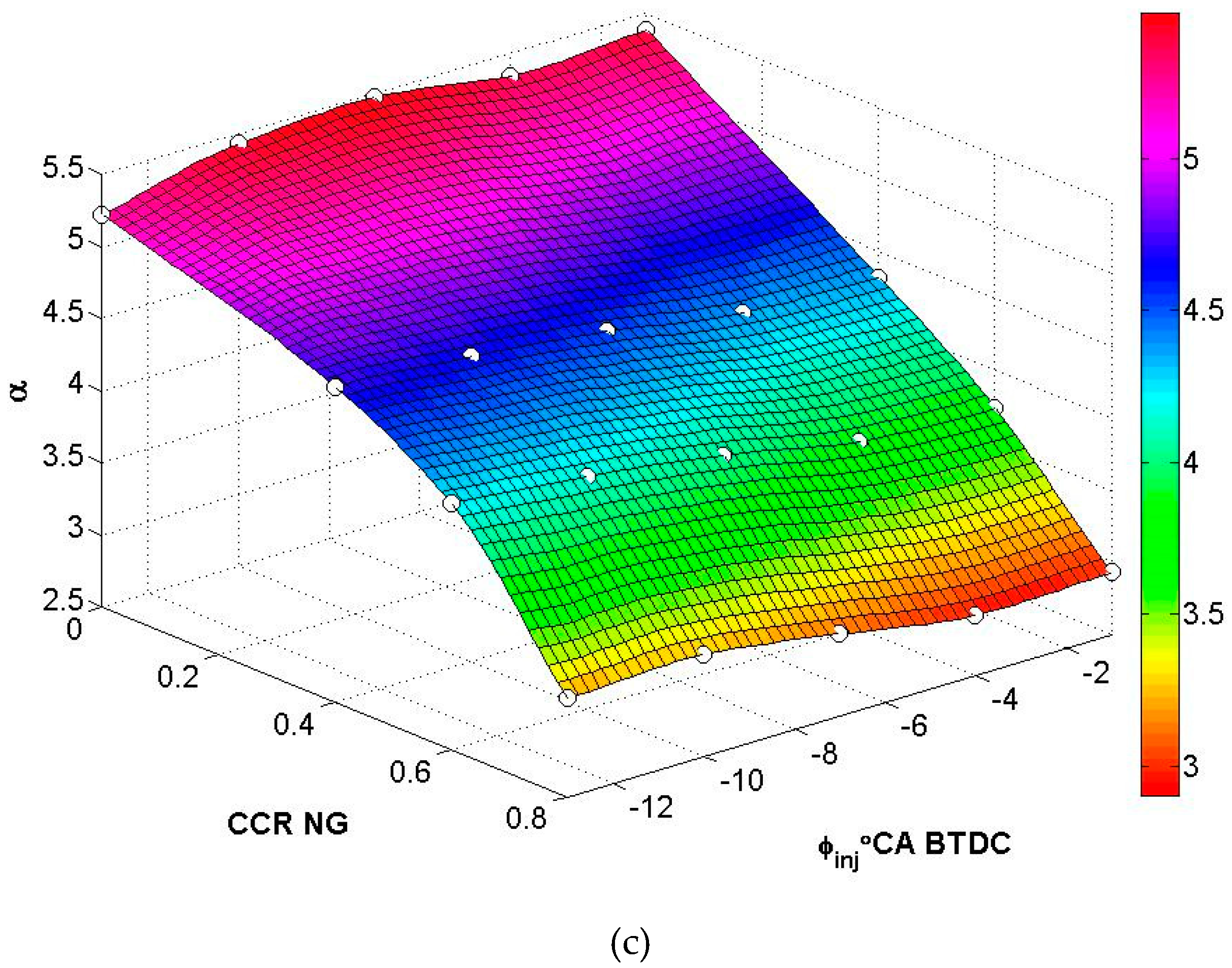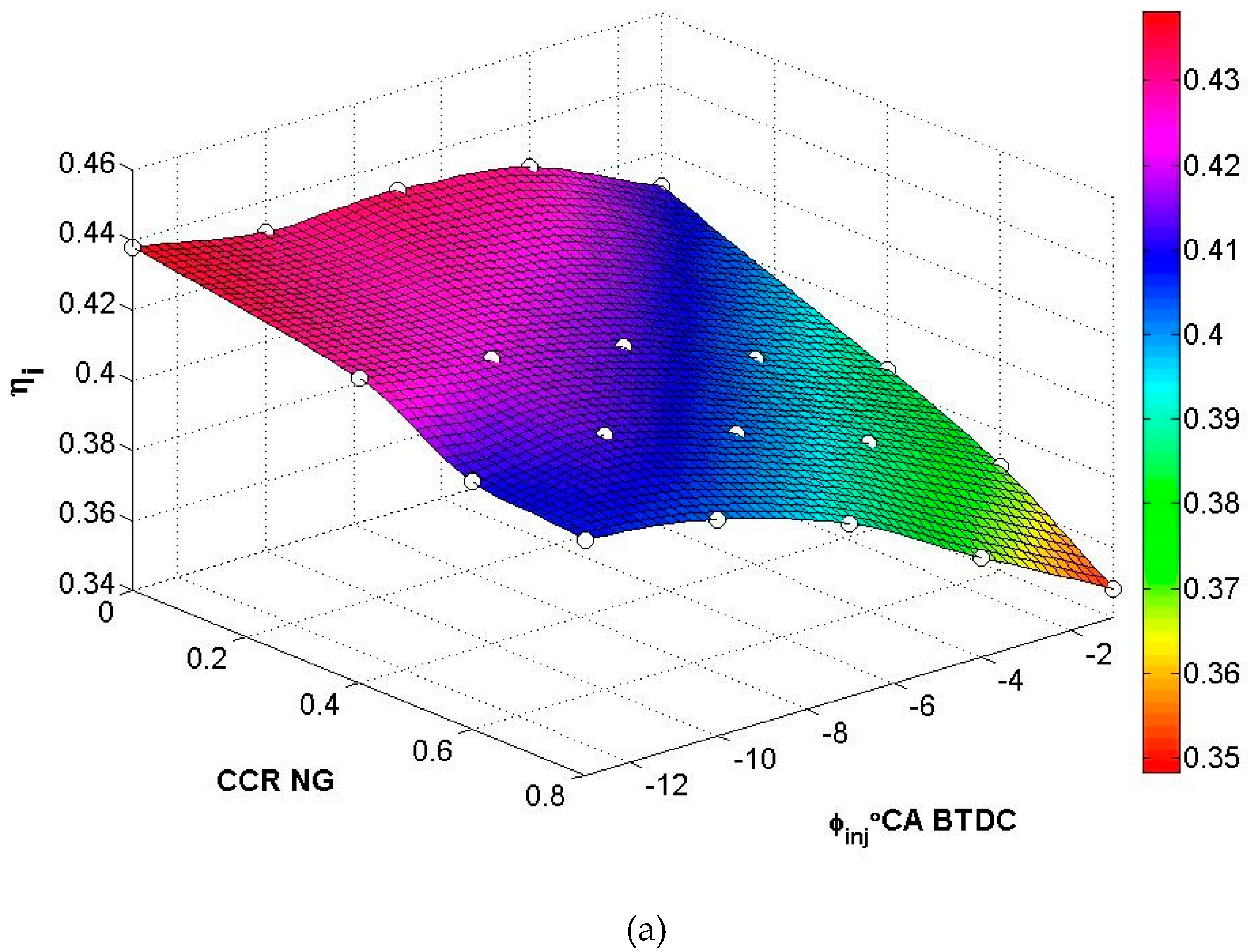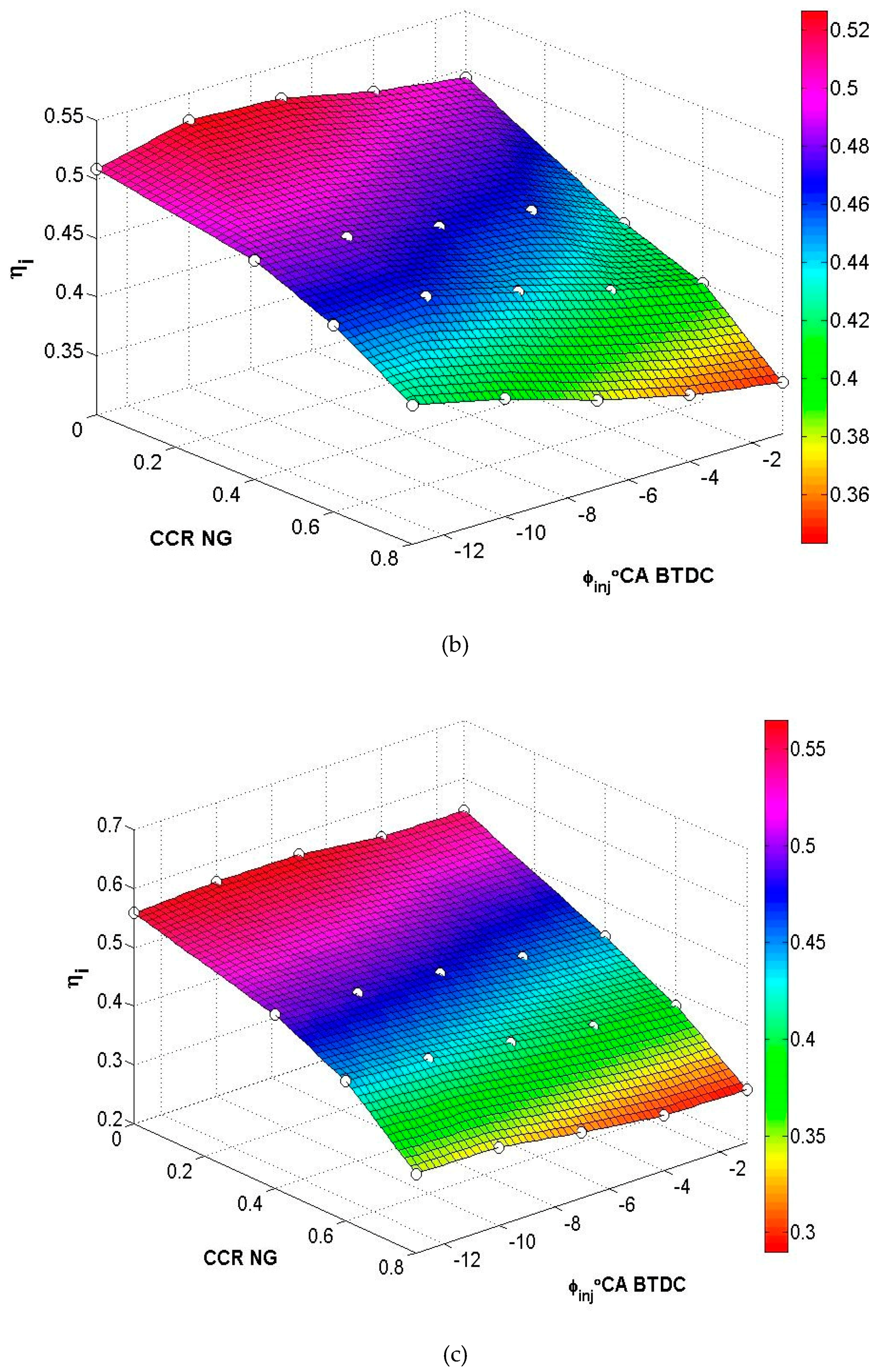1. Introduction
When comparing autonomous heat engines, modern compression ignition engines (CIEs) are characterised by the highest energy efficiency [
1]. This is one of the most important operational indicators, and has a significant influence on the extensive use of these engines in transportation, households, and non-road machines. According to greenhouse gas emission statistics data, CIEs constitute the following parts of the total transport energy balance: 72.1% of the road vehicle sector, 13.6% of marine transportation, and 0.5% of rail transport [
2]. Although numerous CIE processes involve heterogeneous fuel mixture combustion across a large temperature inconsistency (at local temperatures up to 2500 to 3000 K and higher, with an air–fuel equivalent ratio up to 2 to 4 units), a relatively high level of harmful component emission is generated in exhaust gas [
1,
3,
4]. Among the harmful exhaust components, the most dangerous to people’s health and fauna are nitrous oxides and particulate matter (PM), which mainly consist of soot [
1]. Soot particles of 10 μm and less may cause airway diseases such as mesothelioma [
3]. CIEs that burn fuel containing sulphur can release sulphuric oxides that are the main cause of acid rain and can cause damage flora [
5].
Therefore, research on the reduction of harmful emissions into the atmosphere as well as CIE standardisation has become prevalent during recent decades (for example, EN590, EPA, 2012). One of the most widespread technologies is the conversion of CIE for dual-fuel operation and the use of petroleum-derived fuel or either compressed natural gas (CNG) or liquefied natural gas [
6,
7,
8,
9,
10,
11]. The introduction of NG into the cylinder can be achieved with either high-pressure injection or in combination with liquid fuel spray or carburation with air into air inlet manifold. Owing to the inferior NG auto-ignition properties, the fuel mixture may be ignited with electrical discharge, as with Otto engines [
12,
13,
14], or by using a pilot fuel portion or high reaction fuel (HRF) [
15]. The second method for igniting NG is used most frequently, owing to the easy technological realisation of converting CIE to work with NG, without any need for substantial changes in the CIE structure, while the engine can continue to operate on liquid fuel only [
16].
These types of engines, also known as dual-fuel engines, can provide significant improvements in efficiency and emissions [
16,
17,
18,
19,
20,
21,
22,
23,
24,
25]. For example, in research on a dual-fuel cargo truck engine [
26] a decrease in
of up to six times and decrease in
of up to 83% were observed compared to diesel only operation. The MARPOL 73/79 VI annex standard Tier III norms were achieved in a Wärtsillä company average revolution 20DF ship engine when the engine operated with NG fuel feed, without using secondary emission reduction technologies (such as selective catalytic reduction technology) [
24]. Compared to petroleum-based fuel, at least on a theoretical basis, the NG chemical composition contains a carbon/hydrogen ratio that is more favourable for decreasing
emissions responsible for the greenhouse effect by a quarter.
However, serious drawbacks exist when converting a functioning CIE for dual-fuel operation. When using NG greenhouse gas
emissions are reduced because NG, when compared to diesel, has a smaller proportion of carbon atoms, and also the calorific value of NG is 15–25% higher. Moreover, even when there is an increase in HC emissions from using NG, the overall impact on the greenhouse effect is low, when compared to using diesel only [
26]. Also, operation during low load modes results in instability, leading to a reduction in efficiency indicators, and during nominal power load operation and with a large gas fraction of 90% to 95% in the fuel balance, this may result in knocking [
24,
27]. To solve these problems, motor methods are generally used: adjustment of the compression ratio and combustion chamber optimisation [
10,
28,
29], air vortex movement increase in the cylinder [
28], and exhaust gas recirculation (EGR) technology [
24,
26], among others. Research results attest to the conclusion that depending on the operating conditions, the use of NG can increase [
24] as well as reduce instances of engine knocking phenomena [
27]. For example, in numerical research [
24] combustion pressure high frequency pulsation manifests at early and late (by retarding injection timing more than 40 CAD BTDC) pilot fuel injection timing. While at the same time at injection timing from 25 to 40 CAD BTDC pulsations were observed to be minimal. Authors of this publication used a CIE with a conventional fuel injection system. NG had a positive effect and led to a reduction of high frequency pressure amplitude.
HRF characteristic optimisation is a prevalent method, which includes the pilot fuel portion phase, pressure, injection law change, and multiphase injection [
30]. The appeal of this method is related to its relative simplicity, which is relevant for operational CIE conversion, with regulation flexibility across a wide speed and load range, and importantly, enables improvements in engine energy efficiency and emission parameters. The majority of research in this area has been based on complex experimental investigation and internal cylinder mathematical modelling, with respect to the injection phase influence on the operation mixture combustion dynamics. For example, in papers [
24,
25,
30,
31,
32], the physical mechanism and factors leading to the diesel and gas–environment air engine cylinder chemical kinetics as well as process cylinder dynamics were investigated.
In [
30], a one-cylinder (bore 137.2 mm/stroke 105.1 mm) engine with a common rail (CR) fuel injection accumulative system was investigated, and two separate operational mixture combustion physical mechanisms were established, depending on the HRF. The research was conducted on a 25% partial load and partial part gas phase, with an energy value of co-combustion ratio of NG (
CCR NG) of approximately 75%. During the late diesel injection time (DIT), which does not exceed 30 °CA before top dead centre (BTDC), auto-ignition and combustion dynamics were observed, specific to the CIE cycle: OH radicals were grouped closely with HRF torch, initiating intensive combustion in accordance with the kinetic mechanism, with a further transition to flame diffusion transfer into the peripheral combustion bowl zones. Therefore, a relatively small increase in the induction period can be observed by advancing the DIT by 4 to 5 °CA BTDC, and the combustion process is postponed into earlier crankshaft angles; the maximum pressure
and maximum combustion temperature
increase, which leads to superior
emission and efficiency (
). The investigated DIT range of 30 to 50 °CA BTDC operational mixture thermodynamics becomes insufficient for rapid HRF combustion. The double increase in the induction period surpasses the HRF increase, bringing the combustion process back to TDC. The active auto-ignition OH centres include a significant part of the combustion chamber (CC) volume, and the fuel gas–air mixture combustion becomes single phase. The local temperature field in the CC is equalised, thereby reducing the
emissions. Moreover, the reduction not encompassed by the peripheral combustion zones in the CC also leads to a decrease in the emissions of the incomplete combustion products
and
.
Analogous results were found in the DIT range between 50 °CA BTDC and 5 °CA after top dead centre (ATDC) in a high-revolution (bore 85 mm/stroke 90 mm) engine with a common rail system [
1]. Furthermore, the influence of the DIT on the energy efficiency and emissions was established. The authors of the paper have expanded their research by changing the HRF injection pressure in the range of 500 to 1000 bar, optimising the DIT speed, and separating the HRF into component parts, in combination with pressure optimisation. It was established that HRF injection during the early phases is an effective method for improving dual-fuel engine energy efficiency and emissions. A maritime purpose single-cylinder average rpm CIE, Wärtsillä 20DF (bore 200 mm/stroke 280 mm), with a CR system, was also studied [
24].
This research was conducted to establish the HRF distribution and structure, as well as influence of the thermodynamic properties in a compression process on the HRF auto-ignition and fuel mixture combustion process. The experimental research was conducted with medium, nominal engine loads at constant revolutions; the HRF injection pressure was adjusted within the range of 1300 to 2100 bar; the DIT ranged from 15 to 50 °CA BTDC. It was established that, in the DIT range of up to 30 °CA BTDC, the HRF combustion reaction potency, as assessed by the localised HRF equivalence ratio, was high, which is in accordance with the research results. A predominant β value range of 0.2 to 0.8 determines the comparatively short ignition delay of 10 to 17 °CA BTDC and intense combustion. Later, the DIT is accompanied by a noticeable β = 0.2 to 0.8 part reduction, causing a homogenous operational mixture combustion close to the TDC.
Combustion obtains “soft” characteristics, equalising the localised temperature fields and reducing emissions. Moreover, it was established that the fuel mixture thermodynamic parameter changes in the cylinder (by advancing the inlet valve closing phase) are no less effective than the increased HRF ignition delay period. It is important to note that, during this event, the DIT range is significantly reduced: in the conducted experiment from 45 °CA BTDC up to 32 °CA BTDC, emissions were reduced to or below the MARPOL 73/78 Tier III standard established values. Similar results were obtained in an experiment with a six-cylinder engine (Bore 11.2 mm/Stroke 13.2 mm) [
33] with a CR system, by advancing the DIT up to 32 °CA BTDC (
CCR NG 90%), and low load mode emissions were reduced. As opposed to the experimental results from [
23,
27,
28,
30,
34], in which engine parameter deterioration resulted in an increase in hydrocarbon emissions, a reduction in the energy efficiency was observed.
A short overview of the research demonstrates the significance of improving modern engine energy efficiency and emission parameters, changing their operation to NG. However, the separate CIE category conversion to NG operation faces several difficulties. Firstly, problems include models with traditional mechanical fuel injection systems, which exhibit the characteristic of a limited DIT range change and a substantially lower diesel fuel injection pressure compared to the CR system. However, numerous operational CIEs exist with traditional mechanical fuel injection systems. Therefore, the objective of reducing environmental pollution is inseparable from modernising current generation CIEs to work with NG.
Moreover, it should be noted that most research has concentrated on separate speed and load engine operation mode experiments. However, when a fixed
CCR NG gas component exists, there is a lack of data regarding the fuel mixture composition in wide and rational engine work mode ranges, as well as rational dual-fuel distribution in real-life operational range modes. Work that evaluates diesel reading changes under operational conditions has passive properties as a rule, without the realisation of experiments [
4,
26,
35]. This is because of operational health and safety regulations for parameter changes, which limit fast-acting processes.
This paper presents the results from a team of Klaipeda University and Vilnius Gediminas Technical University scientists. The research object was a high-revolution four-stroke engine with a conventional fuel injection system, converted for operation with dual-fuel feed diesel and compressed NG.
The research objectives were as follows:
Rational estimation of the dual D–NG fuel composition, justifying solutions in accordance with energy efficiency, emissions, and reliability values, while the engine is operating in a wide range of modes.
The influence of fuel injection timing on the characteristics of the conventional injection fuel system engine.
The evaluation of rational directions of a converted dual-fuel CIE operation process, with the purpose of establishing a higher level of energy efficiency and environmentally friendly effectiveness.
3. Research Results and Discussion
The conversion of a CIE for operation with NG fuel feed encompasses the evaluation of energy efficiency, emissions, and reliability values (cylinder used, piston group detailed mechanical load ratio criteria, and maximum cylinder pressure).
3.1. Changes in Energy Efficiency
The effective
and indicated
efficiency were used as the energy efficiency parameters. Changes in the parameter
when increasing
CCR NG in different load and rpm modes (
), and the injection timing
range results are provided as well (see
Figure 2).
It should be noted that the obtained dependencies
are qualitatively and quantitatively identical to those of an engine operating in the investigated revolution range of
(see
Figure 2).
Based on this change in the CCR, the engine parameters were specified as n = 2000 min−1.
The load characteristics at and data were limited, only disclosing their specific features. However, the CCR NG quantitative influence did differ strongly for different load modes.
Operating in a mode close to the nominal engine load
CCR NG, the increase in the influence on the
parameter was minimal: a 0.8% to 1.8%
decrease for every
CCR NG increase of 10%. The range top limit values were obtained with relatively low process dynamics, at
°CA BTDC; lower values are specific to processes with high work process dynamics at
°CA BTDC (see
Figure 3).
The analysed change was evaluated as one of the most technologically simple measures, capable of improving the engine parameters for dual-fuel operation. Moreover, an experiment on the changes in within the range of °CA BTDC was conducted to expand the obtained results for engines with different dynamic characteristics (, pressure increase for maximum speed, average speed, and pressure increase for (λ)).
The MLM
parameter
decreased for every
CCR NG increase of 10%, making up 2.5%
3.5%, and for the LLM
from 4.7%
6.0%. It is possible to adjust the parameter
to improve
for operation with NG in different load modes, and
differs significantly. When the engine is operating in the HLM
advancement
to 3 °CA BTDC, compensating for the negative effect of an increase in the CCR increase on
(
Figure 3).
Overall, it is rational that for every CCR NG increase of 20%, there should be an advancement of by 3 °CA BTDC. The obtained results are specific to the investigated range, which means that it is applicable for engine models with different operational process dynamics: in the investigated object, the pressure increase was changed (where is the final compression pressure) within the range from 0.9 to 1.8.
In the MDL mode, the influence of the parameter on decreased. In order to compensate for the decrease with the engine operating on NG, it is necessary to advance to 3 to 6 °CA for every 20% increase in CCR NG: the lower limit values are consistent with a low dynamics process. For the LLM , the injection timing must be advanced to 912 °CA or even more.
The adjustment of
for improving
is inseparable from the necessity to control the operation process dynamic parameters, including the maximum cycle pressure, in order to avoid mechanical overloading of the engine. The overall tendency of the investigated engine load
is that a decrease in
occurs with an increase in
CCR NG (see
Figure 4). It is known that the size of
is determined by the heat release
at the maximum pressure phase
[
37,
38,
39,
40]. The size is mainly formed by the heat released during the first kinetic phase, which is influenced by the auto-ignition delay period
. A decrease in the amount of fuel injected through
or in the period of injection
ensures a decrease in
[
41,
42,
43]. The
dependence on the
CCR NG portion variable is nonlinear: at a
CCR NG increase of up to 0.4,
changed only slightly; however, when the
CCR NG increased to a larger portion than 0.4 and up to 0.8, the decrease in
reached 10
15 bar (see
Figure 4).
Therefore, it is appropriate to increase the
CCR NG and compensate for the
losses with an increase in
. Thus, in order to evaluate the changes in
for CIE conversion for operation with NG fuel feed it is necessary to use different portions of NG, such as
CCR NG 0
0.2 and 0
0.4.
Figure 5 provides the engine indicator diagrams with the speed of heat release characteristics
.
For every engine load mode, the diesel auto-ignition phase for
did not change in the
CCR NG portion range from 0 to 0.8. The ignition delay period
also did not change for
in all investigated
. Overall, the decrease in
can be linked to the changes in the heat release dynamics when the
CCR NG is increased. A decrease in the diesel portion decreases the heat release in the heterogeneous combustion kinetics phase, and increases the total energy balance part of the NG volume specific combustion part [
18,
23,
44]. The combustion process moves towards an expansion stroke, and therefore the decrease in
occurs in parallel with the deterioration in
.
The advancement of the injection timing
moves the combustion process towards TDC, compensating for the changes in
relating to the
CCR NG increase. However, the
advancement in engines with conventional fuel injection systems exhibits limited capabilities in the aforementioned range. One method for improving the
characteristics is accelerating the combustion process in the second (main) phase, which forms the energy efficiency indicators of the cycle. In order to achieve this, the cylinder air load is increased; moreover, the fuel portion vortex movement degree is increased by using different technological methods, such as incorporating fuel additives [
42,
43].
In the HLM, in which the
CCR NG constitutes 0.2, to compensate for the deterioration in
,
is advanced to 3°CA BTDC, and the maximum cycle pressure is increased to 7
10 bar (see
Figure 4). In the MLM, the
advancement to 6°CA BTDC leads to an increase in
up to 15
25 bar: the result is that
is at a larger pressure than that obtained by using diesel only (
CCR NG = 0).
The LLM can reach 2025 bar. Although is lower during the medium and low load modes compared to the modes that are closer to the nominal engine load, and engine operation in the HLM only occurs for a limited time, a meaningful increase can significantly decrease the engine reliability. Therefore, it is not considered as rational for practical use. A CCR NG increase for the LLM up to 0.4, together with a advancement to 6 °CA, can lead to an increase in to 1525 bar.
During the MLM, the increase can reach up to 30 bar and more. It should be noted that changes in are established when the engine is operating with diesel fuel feed in a stationary state of, or low process dynamics. When the system is in a higher state of or in a more dynamic DE operation state, the advancement of becomes irrational: for a small restoration effect, a large increase in is necessary.
Overall, it should be stated that application of the advancement to compensate for the decrease in energy efficiency when the engine is operating in the dual-fuel mode is limited during the HLM and portions of the CCR NG from 0 to 0.4.
The exchange of diesel for NG and the use of NG in different load modes are essentially expanded by applying the advancement method, when there is also a decrease of approximately 3%. The LLM CCR NG is expanded to 40%, while the MLM possible CCR NG application reaches 20% when decreases of 34% and 6% occur, respectively. An increase occurs when operating with diesel fuel equal to 7 bar, which remains unchanged.
3.2. Emission
The engine emission evaluation is directly related to the engine purpose. Vehicle engines are regulated by international standards throughout the entire range of harmful emissions:
, as well as PM [
45,
46,
47,
48]. Moreover, marine-purpose DEs are regulated by MARPOL 73/78 convention Annex VI [
49] for
and
emissions. However, as opposed to DEs for other purposes, marine power plants are also regulated by the decision of the International Maritime Organization to limit greenhouse gas
emissions [
50]. Therefore, it is correct for the evaluation of converted dual-fuel engine emissions to be conducted in accordance with their purpose.
3.2.1. Nitrous oxides
The majority of research has pointed out that CIE conversion for operation with NG fuel feed fundamentally decreases
emissions, owing to the equalisation of the combustion temperature field in the cylinder and decrease in high-temperature zones [
45,
46,
47,
50]. The results obtained from this research agree with this tendency. The effects of the
mission decrease with an increase in the CCR are nonlinear – the maximum effect in the investigated options was detected in the
CCR NG > 40% range. The
mainly decreased in the LLM
.
Moreover, depending on the stationary
value while operating on diesel only, for every
CCR NG increase of 10%, the
emissions decreased by 7% to 3% in the HLM, and 9% to 10% in the MLM and LLM (earlier values of
exhibited lower changes in
emissions). With this manner of exchanging diesel for NG, the
decrease constitutes approximately 65% in the HLM, and a decrease in
of 90%
95% can be reached in the MLM and LLM (see
Figure 6).
However, the
CCR NG increase is followed by a decrease in
of up to 20% in the MLM and 45% in the LLM. It is obvious that the changes in
and
must be coordinated, for example, by applying the
advancement method (see
Figure 6).
A CCR NG increase to 0.2 in the HLM was implemented practically without a significant decrease in the energy efficiency; therefore, even without the use of advancement, the emissions decreased. When increasing the CCR NG portion up to 0.4, it is rational to use a limited advancement solution, which will ensure a certain amount of and reduction. For example, in the HLM, a advancement to 3 °CA BTDC instead of 6°CA BTDC ensured a reduction in and of 3% and 0.9 g/kWh, respectively. Without changing, was reduced by 6.5%, and the emissions were reduced by 1.21.7 g/kWh or 35% compared to the engine operating on diesel only.
In the MLM, a partial deterioration of the compensation with a change in ensured a decrease of 0.71.1 g/kWh or approximately 15%. In the LLM, exchanging 0.2 of diesel with NG, without adjustment, a reduction in emissions of 23.3 g/kWh or 50% was achieved.
3.2.2. Carbon monoxide
According to various sources, the conversion of a CIE for dual-fuel operation is related to a significant increase in harmful partial combustion components, such as
and HC emissions [
45,
46,
47,
48]. During the experiment, it was determined that when a portion of
CCR NG of 0.8 was reached, the CO emissions increased 8 to 30 times in the HLM from the base level of 0.5 g/kWh, 20 to 30 times in the MLM from approximately 1 g/kWh, and 10 to 20 times in the LLM from approximately 2 to 6 g/kWh, during different operation dynamics (see
Figure 7).
In the investigated range, advancement becomes an ineffective measure for emission control. Overall, for CCR NG 0.2 and 0.4 portions, an increase in emissions could be detected in the HLM of 3 to 5 g/kWh and 5.5 to 10 g/kWh, and in the MLM, with CCR NG 0.2, an increase occurred for 7 to 10 g/kWh.
3.2.3. Hydrocarbons
No less intensive is the HC increase when the engine is operating on NG (see
Figure 8).
The HC emissions increased when the engine load was increased, and the influence of the advancement was not significant. In the HLM, for every CCR NG portion increase of 0.1, the HC emission increase constituted approximately 0.1 g/kWh; when the CCR NG was in the range of 0.6 to.8, the HC emissions increased by 0.15 to 0.4 g/kWh. In the MLM, for an analogous CCR NG portion, the HC emissions increase constituted 0.4 to 0.6 g/kWh and 0.7 to 1.5 g/kWh, respectively; for the LLM, the values were 1 to 1.5 g/kWh and 2.5 to 3.0 g/kWh.
3.2.4. Carbon Dioxide
Greenhouse gas
emissions from internal combustion engines are dependent on two factors: the carbon
in the fuel chemical composition and fuel consumption [
45,
46,
51]. Compared to diesel, the NG chemical composition has a
part of 75% versus 85% to 86%. Thus, engine conversion for operating on NG at the same mass portion results in a decrease in fuel consumption and therefore reduced
emissions.
During the experiment, a decrease in
was only achieved for the HLM
in the entire
CCR NG portion range from 0 to 0.8 (see
Figure 9).
Moreover, the advancement reduced the emissions in the CCR NG portion range from 0 to 0.8: when −1 °CA BTDC, the emissions decreased by 9%, for = −13°CA BTDC, the decrease could reach 16%. For the MLM and LLM, the increased emissions led to a deterioration in energy efficiency. Overall, in the mode of for a range up to a CCR NG portion of 0.6, the increase in emissions practically remained unchanged, and with a further increase in the CCR NG up to 0.6 to 0.8 in the LLM, the increase totalled 30% to 45%.
The overall effects of the CIE conversion for dual-fuel operation on the energy efficiency and emissions are provided in
Table 8.
The evaluation encompassed different compensation possibilities, from advancement from full establishment when the engine was operating on diesel to.
When diesel is exchanged for NG (CCR NG 0.2), it is more rational to use partial advancement (with the purpose of re-establishing a proper). In the mode, where a decrease in of 3% to 3.5% was observed, the increase in did not exceed 5 bar. A significant decrease in was achieved at 1.2 g/kWh, the HC increase did not exceed 0.2 g/kWh, and the emissions decreased. For the MLM with , the deterioration also did not exceed 3% to 3.5%, increased by 7 to 9 bar, and decreased by 15%.
A CCR NG portion increase to 0.4 it is more appropriate for use in partial advancement. The engine parameter changes are not significantly different from those of the CCR NG 0.2 values. An effect of a decrease of approximately 15% in emissions detected compared to operation on diesel only.
However, the HC emissions increase is not critical, because a valid standard regulates the total
HC emissions [
52]. The sum of the
and HC emissions in the investigated engine conversion to NG was decreased, because the decrease in the absolute
exceeded the increase in HC emissions (see
Table 8). As a result, the only increase was in the CO emissions. Very few road transport engine CO emissions are regulated by secondary harmful emission control technologies (oxidation-type neutralisations) [
45,
46,
47,
51,
52]. Moreover, marine-purpose power plant CO emissions are not regulated. However, DE conversion for dual-fuel operation purposes exhibits complex improvements in energy efficiency and emission values for conducting research and identifying rational solutions.
3.3. Engine Parameter Improvement Field Evaluation
With reference to previously conducted research on HRF, an injection timing advancement in the range of −1 to −13 °CA BTDC to improve converted CIE operation into dual-fuel is not very effective, because it is strongly related to an intensive increase in and .
The search for rational engine parameters has mainly focused on improving the energy efficiency—particularly the operation indicated process efficiency
. Based on internal combustion engine classical theory rules [
39,
40,
52,
53], changes in
during experiments and improvement reserves are analysed in coordination with heat release dynamics in the engine cylinder, as well as the main operation process parameters (air excess ratio
, dynamic parameters such as
, and auto-ignition delay period
, among others).
As established in
Section 3.2, the increase in the
CCR NG under
conditions influences the combustion process movement towards expansion stroke, and increases the combustion process period—one of the main
influencing factors (see
Figure 10). The graph in
Figure 10 contains integral heat release characteristic data in the relative form of
, and indicates a partially meaningful decrease about
during the expansion stroke, which is even more evident when there a larger portion of
CCR NG and lower engine load exist.
Larger changes in are characteristic for low dynamic engine cycles (. For an earlier , the differences among the characteristics decrease.
For change evaluation of the quantitative heat release characteristics, the relationship with the
uses 50% of the released heat phase
in practice is commonly applied to engine cycle process energy efficiency evaluation [
30,
33]. A direct relationship exists between the
CCR NG and
parameter interaction: in the HLM, when
increased from 0 to 0.8, an increase of
occurred; in the MLM, an increase of
occurred; and in the LLM, an increase of
occurred. When increasing the engine cycle dynamics (
, the
exchange of
CCR NG in equal parts decreased intensely; for example, up to
and
for the MLM and LLM, respectively.
Based on the postulate that the ignition delay has a significant influence (
, based on evaluation of the I.I. Vibe heat release model) on
[
54,
55,
56], it is appropriate to analyse the relationship between
and the engine cycle parameters. For this purpose, Woschi’s mathematical modelling I.I. Vibe combustion period
analytical dependency on the engine cycle implementation parameters was used [
57,
58]:
Here, the “0” index is assigned to the respective parameter values, and is also known as the “basis” engine cycle mode, for which it is usual to accept the nominal power mode;
indicates the engine revolutions;
is the excess air ratio; and
and
are engine constants over a wide range of fuel types [
56,
57]. It should be noted that the
dependency was established based on a large scope of diesel engine experimental data.
In accordance with the
expression during
, the variable (
) remains the main influencing factor on the
period, as well as when evaluating the relationship between
and
, and the energy efficiency in the engine cycle parameter
[
58,
59]. A change in the
CCR NG fuel portion in different load modes attests to the following (see
Figure 11):
An increase in the amount of CCR NG has an inverse effect on the value, which can be explained by a partial exchange of air with NG, as well as NG having a larger stoichiometric coefficient compared to diesel—17 kg air/kg NG versus 14.6 kg air/kg diesel when the engine is operating in different modes (when the engine is operating in different modes, the CCR NG/air inlet pressure remains constant).
The largest effect from the CCR NG fuel portion on was detected in the LLM, and decreased significantly when was advanced.
The changes in the parameter (
) are attuned with the changes in the parameter
arising from the same factors of
CCR NG and
(see
Figure 12 compared to
Figure 11).
On this basis, the composed graphical
and α dependencies (see
Figure 13a) confirm that α has a meaningful influence on the engine cycle
. The investigated engine load modes of
exhibited similar dependencies of
, independent of the
CCR NG and
values. The determinant coefficient
= 0.8 to 0.994 attests to the strong correlations of the
and α parameters.
The ratio change of the dependency of parameters
and
comes close to a functional with
(see
Figure 13b).
In a practical sense, the increase in the parameter (
) for a converted DE does not result in many technological difficulties. The increase in the supply of air to the ICE engine cycle can be ensured by changing the air compression equipment to that with a higher capacity or modifying the current compressor [
52].
The established relationship between
and α attests to the fact that α is not the only variable that forms the
value. The engine cycle energy efficiency is also determined by other factors, because it is demonstrated that an increase in the engine load, at the same values of α, leads to an increase in
(see
Figure 13a). Additional factors influencing
may be other engine cycle dynamics parameters:
and the change in pressure
(here,
is the pressure at TDC) [
58]. An increase in the load leads to an increase in the engine cycle dynamic parameters. It also likely that an increase in the fuel macro- and micro-turbulence influences the combustion intensity positively [
40,
58]. During large load modes, an increase in the air inlet pressure and the respective air–NG mixture movement speed through the air inlet valve accelerates the fuel combustion main diffusion phase, resulting in an increase in
[
59].
Micro- and macro-turbulence accelerate the active radical OH and local combustion centre diffusion into the cylinder periphery, ensuring an entire volume combustion process [
40,
60].
An analogous energy efficiency increase result was obtained in the works of [
28,
33], where a non-traditional CIE cycle HRF injection timing angle advancement of up to 50 °CA BTDC was used. As noted previously, the energy efficiency increase of a converted CIE for dual-fuel operation also manifests itself as a method for emission control when operating on NG. An increase in the air mass during the engine cycle leads to a decrease in the PM, CO, and HC emissions [
19,
61,
62,
63]. As well as the temperature field being equalised in the cylinder during combustion, there is also a decrease in the number of combustion centre concentrations in the cylinder, and as a result, a decrease in the
emissions [
27,
33,
63]. An important improvement effect on
is the greenhouse gas
emission decrease, as observed in the LLM and MLM, owing to the smaller portion of carbon in the chemical composition of NG of 0.75 compared to diesel with 0.86.
